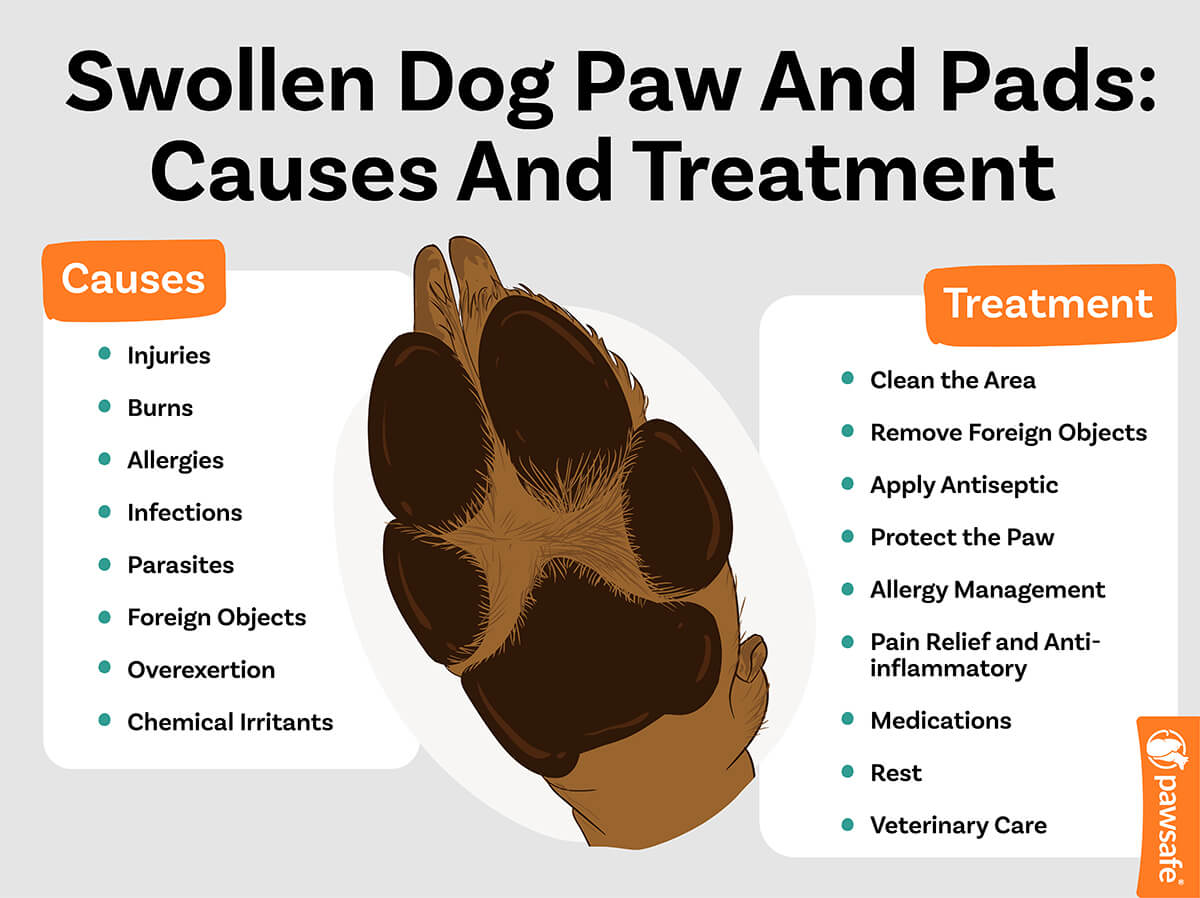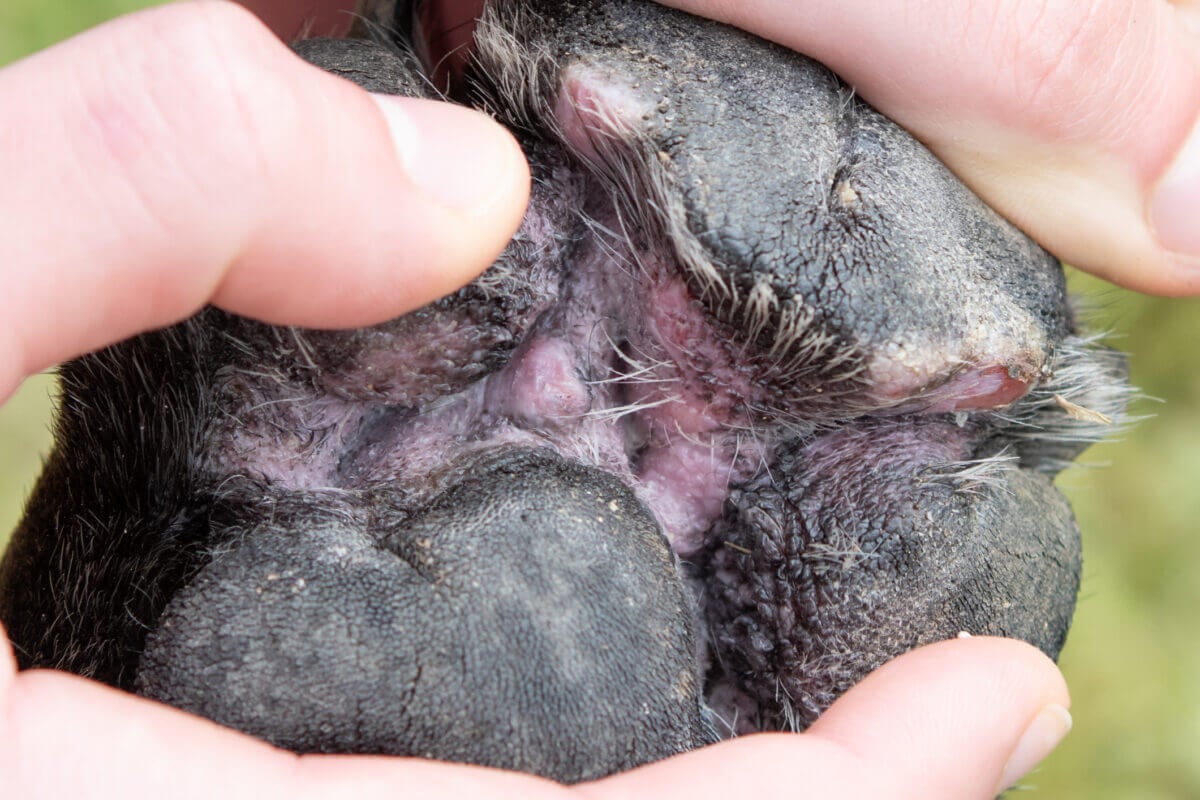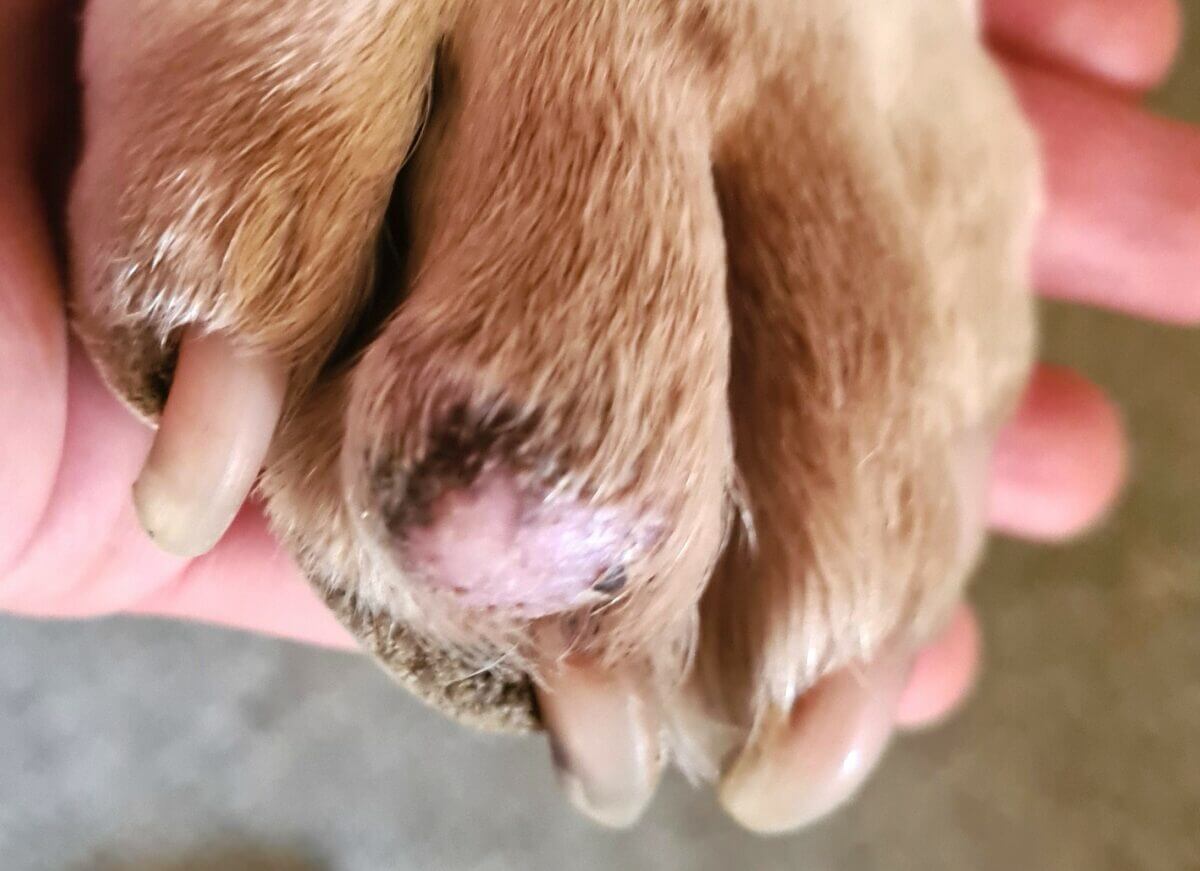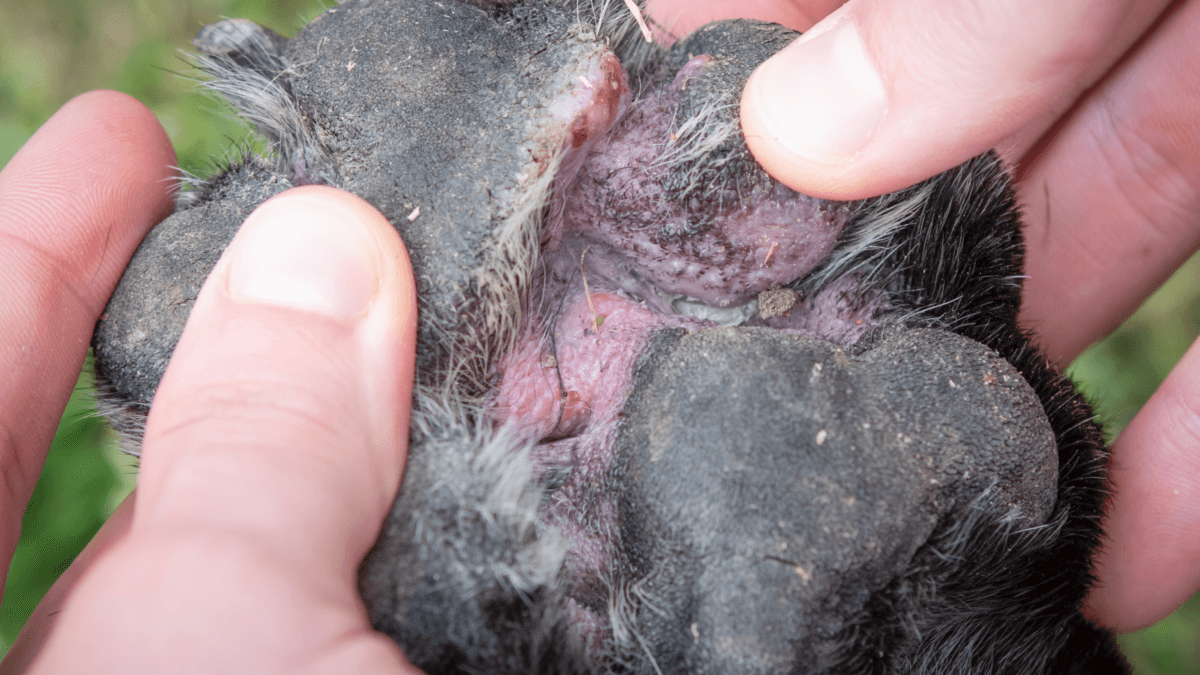
Discovering your dog with swollen paws or paw pads can be alarming for any pet owner. These symptoms can be signs of various conditions, ranging from minor irritations to more serious health issues. To navigate the complexities of swollen dog paws and paw pads, we turn to the insights of Dr. Steven F. Swaim, DVM, MS,[1] an expert in veterinary medicine with extensive knowledge in treating canine paw injuries.
Dr. Swaim’s research[2] sheds light on the intricate care required for paw injuries and infections, emphasizing the importance of understanding the underlying causes to provide the best treatment for our furry friends. In this article, we’ll explore the common reasons behind swollen dog paws, how to treat them, and when it’s crucial to seek veterinary care, ensuring your dog’s paws remain healthy and pain-free.
Table of Contents
So, Why Does My Dog Have Swollen Paw Pads?
Common causes of swollen paws pad include allergies, cuts, lacerations, foreign objects lodged between toes, nail issues, paw or toe injuries, and cysts. The usual cause of swollen dog paw pads is canine pododermatitis. The causes of pododermatitis in dogs can be grouped into infections & foreign bodies, immune and metabolic disorders, cancer, genetic disorders, and trauma.
Regularly Inspecting your puppy’s paws is fundamental to catching paw problems early on because many of these causes are pretty easy to spot at home. Before we get into what causes swelling in your dogs toes and paws, let’s first understand the condition called pododermatitis in dogs.
The paw pads are remarkably resilient and durable, explaining why dogs and other animals don’t have to wear shoes. Despite the resilience, paw pads can be candidates for various issues which may be frustrating to diagnose and treat.
If your canine friend has paw problems, they’ll exhibit signs and symptoms you can’t miss. Other signs and symptoms to look out for include:
- Your pup limping;
- Licking the problematic paw;
- Aggression when you touch the paw;
- Red, inflamed paws;
- Lesions and discharge on paw pads;
- Bleeding;
- Ripped nails;
- Foul smell;
- Ulcers ; and
- Cysts and growths.
If symptoms persist, the best course of action is to take your pup to the vet for medical attention. Waiting too long before treatment leads to the paws developing secondary infections, which can be even harder to treat.
Canine Pododermatitis: A Closer Look at Swollen Dog Paws

Paws, while adorable and crucial for our four-legged friends, can encounter numerous challenges, including a condition known in studies as Canine Pododermatitis. Let’s explore this in an easy-to-digest manner, shall we?
Deciphering Canine Pododermatitis
Envision your dog’s paw as a durable yet sensitive cushion that experiences various terrains and elements during their explorations. Canine Pododermatitis arises when this paw becomes inflamed, resulting in noticeable redness, swelling, and potential pain for your pup, according to studies.
Interestingly, paw issues might have varied causes, spanning from infections, parasitic adventures, allergies, metabolic conditions, genetic factors, to accidents like stepping on a sharp object. A noteworthy point for pet parents: Demodicosis, especially in adult dogs (older than 4 years), is often misdiagnosed, affecting the feet and resembling other skin diseases. Another troublesome condition includes deep pyoderma which causes nodules and recurring draining tracts in the paws.
Signs of Pododermatitis in Dogs
Should your dog exhibit limping, persistent paw licking, aggressiveness upon paw touching, or if the paw appears red and swollen, it’s a sign of concern.
Studies[3] and research shows additional symptoms to watch for:
- Limping or lameness;
- Discharge or lesions on the paw pads;
- Bleeding or torn nails;
- An unusual odor; and
- Ulcers, cysts, or abnormal growths
While online research is tempting and informative, persisting symptoms warrant a professional look. Procrastinating on a vet visit might pave the way for complicated secondary infections.
13 Common Causes of Swollen Paw Pads in Dogs

There are many reasons your pup may be suffering from swollen paw pads, so let’s break down all the reasons and what to look for.
1. Dermatitis (Atopic, Contact, & Allergies)

Flea allergy dermatitis occurs when your dog is allergic to flea bites, and can also cause swelling if the fleas bite the paws. Seasonal allergies occur during certain seasons, mostly caused by pollen grains. All these allergies result in uncomfortable itchiness in your dog’s, medically referred to as pruritus.
Dogs biting the paws due to itchiness can also cause excess moisture and secondary infections that may result in swollen toes and paw pads.
The moist environment caused by intensified paw licking makes the paw pads susceptible to secondary fungal and bacterial infections, including nail fungus. Irritation, injury, and secondary infections only heighten paw swelling, so prompt medical intervention is necessary before the matter worsens.
Solutions
- Get your dog checked out by the vet if you suspect an allergy;
- Wipe your dog’s paws after being outdoors if they’re allergic to pollen; and
- Give your dog antihistamines once your vet approves of their safety.
2. Walking on Harsh Terrain

Running over jagged, overgrown terrain can cause your dog’s paws to swell because foreign objects get stuck between the paws. Your dog’s paws may burn on hot asphalt on sunny days. If the pavement is too hot for you to walk on barefoot, it’s not safe for your dog to walk on either.
Burnt paw pads manifest as redness and blisters and they swell. A quick test would be to place your foot on the ground for 10 seconds, and if your foot burns, it’s best to keep your pooch home. It’s easier to walk your dog in the evening to avoid the foot on the hot ground hustle.
Solutions
- Watch out for sharp objects and thorns when your pup is out playing;
- Invest in paw protection like doggy boots if your dog walks on rough and hot grounds; and
- Inspect your outdoor-loving dog’s paws regularly.
3. Bacterial or Yeast Infections
Ah, paws – the cute little footsies that take our furry friends on all sorts of adventures. But, what happens when these adventure-seekers encounter some bacterial and fungal foes, such as Deep Pyoderma and Malassezia? Let’s dive into these tricky topics and discuss how they might impact our canine companions!
Deep Pyoderma/Furunculosis: The Bacterial Bully

Symptoms
Deep Pyoderma, also known as furunculosis when it’s in the deeper skin layers, tends to bring along unpleasant gatherings of pus-filled bumps, often between the toes. Your pup may start limping, excessively licking their paws, or display redness and swelling in the paw region.
Treatment
Anticipate a vet-prescribed antibiotic party to fend off the bacterial invasion, usually lasting between 6 and 12 weeks. Regular bathing with medicated shampoos can also assist in calming inflammation and keeping the area clean. Patience is key, as this bacterial bully might take a while to fully vacate the premises!
Malassezia: The Fungal Fiend
Symptoms
Malassezia, a naturally occurring yeast, turns villainous when it multiplies excessively. Your dog might encounter persistent itchiness, redness, and a musty odor (like corn chips or Fritos) emanating from their paws. Often, you’ll find them nibbling at their feet or sliding them along your carpet in an attempt to find some relief.
Treatment
Antifungal medications, whether oral or topical, are generally the go-to here. Medicated shampoos and wipes that target yeast can also be particularly helpful in managing symptoms. Sometimes, an underlying issue (like allergies) might be encouraging Malassezia’s mischief, so addressing that root cause is crucial for keeping this fungal fiend at bay.
In both cases, the “what to give” in terms of treatment isn’t a one-size-fits-all and should ideally be guided by a veterinarian. After all, when it comes to battling these microbial miscreants, a personalized plan of attack is sure to be the most effective strategy.
Dermatophytosis: Fungus Among Us!
Symptoms
This skin infection caused by fungi, also known as “ringworm,” might cause patchy hair loss, redness, and sometimes a crusty appearance on the paw pads. Your dog’s feet might become itchy and swollen, prompting them to seek relief through licking and nibbling.
Treatment
Antifungal medications, whether topical or oral, are the standard counterattack against dermatophytosis. Special shampoos, creams, or even dips might be suggested by your vet. It’s worth noting that this fungus enjoys socializing and can spread to other pets and even humans, so isolating your affected pooch and thoroughly cleaning their environment is crucial.
4. Interdigital Furunculosis in Dogs
Interdigital Furunculosis[4], a condition marked by swelling and infection between the toes in dogs, is a common cause of discomfort in dogs. Often stemming from bacterial infections, this ailment can be aggravated by moisture trapped in the paw pads or underlying health issues such as allergies. Symptoms include persistent paw licking, limping, and visible inflammation or discharge in the affected area. Addressing this condition typically involves a combination of antibiotics for the infection and sometimes corticosteroids to reduce swelling. Maintaining clean, dry paws is essential for recovery, and in severe cases, surgical intervention may be required to remove the cysts.
5. Acral Lick Granuloma
Acral Lick Granuloma[5] arises when a dog excessively licks a specific area on its leg, leading to a thickened, inflamed lesion. This behavior may be driven by psychological factors like stress or boredom, though it can also indicate physical discomfort from conditions such as arthritis.
The constant licking exacerbates the inflammation, creating a cycle that’s difficult to interrupt. Identifying and addressing the root cause, coupled with strategies to distract and soothe the dog, are key to managing this condition. In certain scenarios, medical treatment may be necessary to alleviate the underlying discomfort.
6. Dry and Chapped Paw Pads
Dryness can have numerous negative consequences on your dog’s paw pads. Similar to humans with oily or dry skin, some dogs’ paws are sensitive to drying and even chapping in extreme cases. Endocrine disorders like hypothyroidism and autoimmune issues can cause the skin around the feet to dry up.
Other factors that cause paw pad drying include allergies and nutritional deficiencies. If the air in your home is too dry, you’ll notice your dog’s paws and nose drying. Your dog may lick the dry paw pads intensely, causing self-inflicted trauma if the licking occurs too frequently.
Solutions
- Invest in a quality dog balm and apply it to the dry parts;
- Get a humidifier to keep the air adequately dampened;
- Treat or manage allergies that may cause the paw pads to dry;
- Wipe the paws after walks in the snow to eliminate de-icing salt; and
- Get your pup to wear dog boots during hot summer days and winter.

See The Quick. Clip With Confidence
LED light and razor-sharp blade help you avoid over-cutting and finish trims fast with less mess.
Shop Now 👉Safe Trim Guarantee • 90-Day PawSafe® Promise
7. Parasites
Demodicosis, caused by Demodex mites, might trigger localized redness, swelling, and sometimes even infections in your dog’s paw pads. Affected dogs often exhibit persistent licking and chewing of their paws, and, upon closer inspection, you might notice thinning hair or bald spots, and sometimes even scales or crustiness around the paws.
Treatment
To tackle this tiny trespasser, a vet might prescribe a special acaricidal (mite-killing) shampoo or spot-on treatment to evict the mites. If secondary bacterial infections have settled in due to all that chewing and licking, an antibiotic might join the treatment team.
8. Nail Problems

Nails have a direct effect on a dog’s paw health. Broken and torn nails are easy to detect upon inspection and make walking harder for your dog. Ripped toenails happen when your dog catches their nail on something on their path. Nail bed infections[6] like in the picture above is also a common cause for the toe and the paw pad to also swell up. Regular nail maintenance can help prevent many of these issues.
You know it’s time to trim the nails when you hear clicking sounds when your dog walks. Well-trimmed nails should end just before touching the ground. Ingrown nails cause pain and swelling, and they occur when you fail to trim the nails properly or when the nails grow too long into the paw.
Solutions
- Trim your dog’s nails every month. Do it carefully to avoid nipping the paw flesh.
- Trim overgrown hair on the paws while you’re on the nail trimming subject.
9. Injuries to the Paw Pads
Physical injuries are among the most common reasons for swollen paws and pads in dogs. Our active and curious canine friends often run, jump, and explore environments where they can injure themselves. From minor cuts and scrapes to more severe conditions like broken bones, the range of injuries that can lead to swollen paws is vast.
- **Cuts and Abrasions – **Running over rough terrain or stepping on sharp objects can cause cuts or abrasions on a dog’s paw pads. Even though these injuries might seem minor, they can lead to swelling and discomfort. Keeping the wound clean and protected is crucial to prevent infection and further swelling.
- **Punctures – **Thorns, sharp stones, or bits of broken glass can puncture a dog’s paw, leading to immediate pain and swelling. Puncture wounds are particularly prone to infection due to the debris that can get embedded deep within the wound.
- **Burns and Blisters – **Hot surfaces like pavements in the summer or chemical irritants can burn a dog’s paws, resulting in swelling, blisters, and significant discomfort. Similarly, walking on icy or salted surfaces during winter can cause damage and swelling to the paw pads.
- Broken Bones – Dogs can suffer from fractures in their toes or the bones of their feet from accidents or high-impact activities. A broken bone in the paw is painful and will lead to noticeable swelling, along with limping or refusal to bear weight on the affected limb.
- **Sprains and Strains – **Vigorous play or awkward landings can strain or sprain the ligaments and muscles in a dog’s paw, causing swelling and tenderness. These injuries might not be immediately visible but can significantly affect a dog’s mobility and comfort.
For any injury, whether minor or severe, it’s essential to seek veterinary attention. A veterinarian can assess the damage, provide appropriate treatment, and give guidance on home care to ensure a swift
10. Immunological Diseases and Swollen Dog Paws
Let’s talk paws and some potentially paw-fusing conditions, particularly focusing on immunological diseases that could be the sneaky culprits behind your pup’s swollen paws. As a heads up, immunological diseases imply that the body’s defense system is, oddly enough, going a bit haywire and attacking its own cells. Here are a few conditions that might be playing hide and seek with your dog’s paw health:
Pemphigus Foliaceus: The Sore Spreader
Symptoms
Pemphigus Foliaceus is like that uninvited party guest who just spreads chaos. It creates sores and crusts, primarily on the face and feet of our canine pals. So if you spot your pup developing crusty paws or if they’re particularly sensitive around their footsie area, this might be the culprit.
Treatment
This one typically involves steroids or other immunosuppressive drugs to tone down the immune system’s overzealous response. Continuous vet visits will be crucial to monitor and tweak the treatment plan accordingly.
Treatment
Identifying and avoiding the allergen is ideal, but we get it, sometimes that’s like finding a needle in a haystack. Antihistamines and steroids might provide relief, and specialized shampoos or topical solutions can be a comfort for those itchy toes.
Vasculitis: The Inflammation Invader
Symptoms
With vasculitis, inflammation is messing with your dog’s blood vessels, often leading to ulcers or dead skin, particularly in the paws, that may also lead to swelling. This may look like discolored patches and, undoubtedly, is as uncomfortable as it sounds.
Treatment
Depending on the cause, vasculitis treatment may involve steroids, antibiotics, or other targeted medications. Addressing the underlying cause (if identifiable) and managing symptoms is the game plan here.
While all this might sound overwhelming, having a heads-up about these conditions enables you to keep a watchful eye on your four-legged friend’s paws and get them the help they need swiftly should anything go awry. And remember, while our chat gives a starting point, a vet’s expertise is unparalleled when it comes to navigating your pup’s health journey effectively!
11. Metabolic Causes of Canine Paw Swelling: A Look at Superficial Necrolytic Dermatitis
When it comes to our pup’s health, the paws can indeed tell a paw-plexing tale. Imagine this: your dog starts showing a peculiar redness and swelling on their paws, and upon closer inspection, it’s not just an ordinary irritation. It might be something deeper, related to their metabolism—like Superficial Necrolytic Dermatitis (SND).
Superficial Necrolytic Dermatitis: A Metabolic Muddle
Symptoms
SND, also known by several other names like Hepatocutaneous Syndrome or Metabolic Epidermal Necrosis, tends to showcase itself quite dramatically on our dog’s paw pads. Common symptoms might include red, swollen paws, and you may notice them getting crusty or scaling. The skin might also become notably thin, and, oh boy, your pup might seem pretty bothered by it, constantly licking or gnawing at their paws in an attempt to soothe the irritation.
What’s Happening Inside
The condition often points to an underlying issue related to the liver and metabolism. The liver plays a vital role in maintaining skin health, and when it’s not working as it should, issues like SND can make a grand, unwanted entrance.
Treatment
Treating SND often involves addressing the underlying liver issue, so it’s not just a matter of soothing those sore paws. Your vet might prescribe a specialized diet that’s easy on the liver and might include supplements to support skin health and liver function. Topical treatments or medicated shampoos might also be suggested to provide some relief for those aching paws.
12. Cancers that Cause Swelling in Dog Paws
Swollen paws might often be an indicator of something not quite right, and exploring the possibilities is crucial in ensuring our pups remain their playful selves.
The Weight of Cancer: Understanding Two Types
Nail Bed Squamous Cell Carcinoma
A fancy name, but let’s break it down.
Symptoms
Look out for a swelling or mass in the nail bed area of your pup’s paw. They might also be experiencing pain, lameness, and perhaps even nail loss. Some dogs may frequently lick the affected paw due to discomfort.
Treatment
Treatment usually involves surgical removal of the tumor, which might sometimes mean amputation of the affected toe. Additional treatments like chemotherapy or radiation therapy may be explored, depending on the stage and spread of the cancer.
Epitheliotropic Lymphoma
Yet another complex term for a condition our dogs could do without.
Symptoms
This type of lymphoma is skin-related and might cause various symptoms, including thickened, red skin, ulceration, and nodules. Yes, those paw pads can become quite inflamed and sore, and you might notice your dog limping or favoring other paws.
Treatment
Treating epitheliotropic lymphoma can involve various approaches such as surgery, radiation therapy, and chemotherapy, often tailored to the specific circumstances and stage of the disease.
These cancer types, while intimidating to think about, remind us that every lump, bump, and swelling is worth checking out. Cancer in dogs, like in humans, can often be managed and sometimes cured if caught and treated early. Always prioritize regular check-ups and maintain an open dialogue with your vet to navigate through any health challenges your dog may face.
13. The Genetic Factor: Familial Paw Pad Hyperkeratosis
Genes – those tiny little building blocks that decide everything from our pup’s coat color to their temperament. And yes, even their health can be determined by their genetic coding. One such genetic condition that might be playing a tricky role in your dog’s paw health could be Familial Paw Pad Hyperkeratosis.
Exploring Familial Paw Pad Hyperkeratosis
Symptoms
A mouthful to say, Familial Paw Pad Hyperkeratosis is an inherited condition that causes the paw pads to become unusually hard and thick. This might appear as if your dog has crusty, dry paw pads, which can be especially uncomfortable if they crack or bleed.
Treatment
While this condition doesn’t have a cure per se, it is something that can be managed with ongoing care. Paw moisturizing and possibly some protective gear for their little feet (think doggie booties) can be a great help. You’ll need to be keenly observant and mindful about paw care to help avoid infections and keep your dog comfortable.
Genetic conditions like this can’t be prevented, but with the right knowledge and support, they can be managed, ensuring your pupper lives a comfortable and joyful life. It’s all about adapting and providing what they need to strut their stuff, happily and healthily.
Navigating through genetic paw conditions involves a combo of love, the right vet advice, and a pawful of patience. Ensuring your dog’s comfort and health always tops the priority list, and together, you can journey through the challenges of Familial Paw Pad Hyperkeratosis, always stepping forward with the best paw forward.
A Comprehensive Guide: What to Give a Dog for a Swollen Paw?

Oh no! Your fur baby’s paw is all swollen and they’re giving you those big, sad eyes. What do you do? Don’t worry, here’s a comprehensive guide to help you navigate through the worry of a dog with a swollen paw.
Initial Steps: Don’t Panic, and Assess
- Examine Gently: Carefully check the paw for obvious issues – cuts, thorns, etc.
- Clean and Protect: Gently wash with mild soap and water, and protect it with a soft bandage if possible.
- Limit Activity: Encourage your pup to rest and try to keep them from licking or biting the area.
Common Causes and What to Provide:
-
Injury:
-
Provide: Rest, gentle cleaning, and sometimes, a protective bootie.
-
Vet Care: If the injury seems severe or if it doesn’t heal within a day or two, consult your vet.
-
Allergies:
-
Provide: Frequent paw washing, hypoallergenic food, and sometimes, a cone to prevent licking.
-
Vet Care: To confirm and address allergies, talk with your vet about possible testing and treatments.
-
Infections (Bacterial/Fungal):
-
Provide: Regular cleaning, dry the paw thoroughly, and avoid moisture-heavy environments.
-
Vet Care: If you suspect an infection, a vet visit is crucial for appropriate medications.
-
Parasites:
-
Provide: Regular flea/tick prevention protocols.
-
Vet Care: If you notice symptoms of parasite infection, your vet may prescribe special medications.
-
Genetic Conditions (e.g., Hyperkeratosis):
-
Provide: Paw balms or moisturizers to soothe and protect.
-
Vet Care: Periodic check-ups and following prescribed care routines.
When to Immediately Consult the Vet?
Sometimes, the situation calls for immediate professional intervention. If your dog:
- Is in Visible Pain: Whining, limping, or acting aggressively when you approach the paw.
- Has a Severe Injury: Deep cuts, broken nails, or foreign objects embedded in the paw.
- Has Significant Swelling: Especially if it’s sudden or comes with other symptoms.
How to Treat a Dog’s Swollen Paw
Initial Care
Clean the paw with mild soap and warm water to remove any debris or contaminants. Check for foreign objects like thorns or splinters and remove them carefully. Apply a cold compress to reduce swelling and inflammation.
Epsom Salt Soak
For infections or to soothe the paw, an Epsom salt soak can help. Mix Epsom salt in warm water and let your dog’s paw soak for 5-10 minutes, ensuring they don’t ingest the water.

From Nervous To Pro In One Session
Guided illumination plus ergonomic grip make precise home trims simple—even for first-timers.
Shop Now 👉Safe Trim Guarantee • 90-Day PawSafe® Promise
Limit Movement
Encourage your dog to rest the affected paw by limiting their physical activity. This helps reduce further injury and speeds up healing.
Protect the Paw
Consider using a protective bootie or bandage to keep the area clean and to prevent licking or chewing that can aggravate the condition.
OTC Human Medications For Swollen Dog Paw: A Warning
When it comes to easing pain or swelling, reaching for human over-the-counter (OTC) medications might seem like a quick solution, but this can be extremely dangerous for dogs. According to the Pet Poison Helpline[8], NSAIDs like ibuprofen (Advil, Motrin) and naproxen (Aleve) are particularly harmful, even in small doses. These can cause serious stomach and intestinal ulcers as well as kidney failure in pets. Acetaminophen (Tylenol), while safe for humans, can lead to liver failure and red blood cell damage in dogs.
Never give your dog any human medications without consulting your veterinarian. If your dog is in pain or the swelling does not subside with home care, a visit to the vet is crucial. They may prescribe pet-safe medications and treatments to address the swelling and underlying causes effectively.
Treating a swollen paw involves careful attention and shouldn’t rely on human medications due to their potential toxicity. Consulting with a vet ensures your dog receives the safest and most effective care for their condition.
Home Remedies For A Dog’s Swollen Paws, Toes, and Pawpads
When your dog ends up with a swollen paw, it’s natural to want to provide immediate comfort. While some cases may require veterinary attention, there are several home remedies you can try to alleviate mild swelling and discomfort:
1. Cold Compress
Applying a cold compress to the swollen paw can help reduce inflammation and provide relief. Use a clean cloth soaked in cold water or a cold pack wrapped in a towel, applying it to the paw for intervals of 10-15 minutes.
2. Epsom Salt Soak
Epsom salt, known for its soothing properties, can help with swelling and minor infections. Dissolve a handful of Epsom salt in warm water and let your dog’s paw soak for 5-10 minutes. Ensure your dog doesn’t drink the water, as Epsom salt is not meant for ingestion.
3. Keep It Clean and Dry
Clean the swollen paw with mild soap and warm water, carefully removing any visible debris or foreign objects. After cleaning, thoroughly dry the paw, especially between the toes, to prevent further irritation.
4. Paw Protection
Protect the affected paw from further injury by keeping your dog indoors on soft surfaces as much as possible. If going outside is necessary, consider using a protective bootie to cover the paw.
5. Limit Activity
Encourage your dog to rest and limit their activity level to prevent worsening the swelling or causing more pain.
6. Monitor and Comfort
Keep a close eye on the swollen paw and your dog’s overall behavior. Offering comfort and staying calm can help your dog relax, which may aid in the healing process.
While these home remedies can be effective for minor issues, it’s crucial to monitor your dog’s condition closely. If the swelling persists, worsens, or is accompanied by other symptoms such as limping, excessive licking, or changes in appetite, it’s important to seek professional veterinary care. Early intervention can prevent complications and ensure your dog receives the appropriate treatment for their condition.
When to See a Vet for Swollen Dog Paws
While some instances of swollen dog paws can be managed at home, there are certain situations where it’s crucial to seek professional veterinary care. Here’s when you should make that vet appointment:
- Persistent Swelling: If the swelling doesn’t subside within a day or two of home treatment, it’s time to see the vet. Persistent swelling could indicate a deeper issue that requires medical intervention.
- Signs of Infection: Swelling accompanied by signs of infection, such as pus, a foul odor, excessive redness, or heat in the affected area, warrants immediate veterinary attention. Infections can worsen quickly and may lead to more serious health problems if not treated.
- Limping or Refusal to Walk: If your dog is limping, unwilling to bear weight on the swollen paw, or appears to be in pain when walking, it’s a clear signal that professional evaluation is needed. This could indicate a fracture, severe sprain, or other serious injuries.
- Visible Wounds or Foreign Objects: Deep cuts, punctures, or the presence of foreign objects (like thorns or glass) in the paw are cases for the vet. These situations can lead to infections or more severe injuries if not properly treated.
- Allergic Reactions: If you suspect the swelling is related to an allergic reaction, especially if accompanied by other symptoms like hives, facial swelling, or difficulty breathing, seek veterinary care immediately. Allergic reactions can escalate rapidly and may become life-threatening.
- Accompanying Symptoms: Swelling that’s accompanied by other concerning symptoms, such as lethargy, loss of appetite, or changes in behavior, should be evaluated by a vet. These could indicate a more systemic issue that needs to be addressed.
- Swelling in Multiple Paws: If more than one paw is swollen, it’s likely a sign of a systemic issue, such as an allergy or autoimmune disease, that requires veterinary diagnosis and treatment.
- Recurring Swelling: A paw that repeatedly becomes swollen over time, despite treatment, should be checked by a vet to identify any underlying chronic conditions.
When in doubt, it’s always better to err on the side of caution and consult your veterinarian. They can provide a proper diagnosis, recommend appropriate treatment, and offer guidance on how to prevent future occurrences of swollen dog paws. Ensuring timely medical care not only helps relieve your dog’s discomfort but also prevents the condition from worsening.

Cleaner, Safer At-Home Nail Care
Built-in light, nail catcher, and durable blade deliver salon-quality results without the groomer bill.
Shop Now 👉Safe Trim Guarantee • 90-Day PawSafe® Promise
Frequently Asked Questions (FAQs)
Is a Swollen Dog Paw an Emergency?
A swollen dog paw can be an emergency depending on the severity and the underlying cause. If the swelling is accompanied by severe pain, limping, or signs of infection (such as redness, heat, discharge, or a foul odor), it’s important to seek veterinary care immediately. Swelling that occurs suddenly and dramatically should also prompt an urgent vet visit.
My Dog’s Paw Pad is Swollen and Red, What to Do?
If your dog’s paw pad is swollen and red, gently clean the area with mild soap and water and inspect it for any visible wounds, objects, or stingers. If the swelling doesn’t reduce or if you notice any pus or discharge, contact your veterinarian for further guidance.
Dog Paw Swollen and Limping, Should I Be Worried?
Yes, if your dog’s paw is swollen and they are limping, it indicates discomfort or pain. It could be due to an injury, infection, or foreign object. Consult your veterinarian to diagnose and treat the underlying cause.
Dog Licking Swollen Paw, Is It Allergies?
Dogs often lick their paws due to irritation or itchiness, which can be signs of allergies. However, other causes like wounds, infections, or foreign bodies can also prompt licking. Observing other allergy signs, such as sneezing, itching, or skin redness, can help identify if allergies are the culprit.
Can a Foxtail Cause a Swollen Dog Paw?
Yes, foxtails can work their way into a dog’s skin, causing swelling, pain, and infection. If you suspect a foxtail is lodged in your dog’s paw, it’s crucial to see a vet, as they can migrate deeper into the tissue and cause more severe problems.
My Dog Has a Swollen Paw Pad and Discharge — Why?
Swollen paw pads with discharge often indicate an infection. This can result from cuts, punctures, or foreign objects like thorns or splinters becoming embedded in the paw. Veterinary examination is necessary to treat the infection and remove any foreign materials.
What is the Treatment for a Swollen Dog Paw Due to a Bee Sting?
For a bee sting, remove the stinger if visible, then apply a cold compress to reduce swelling. Monitor your dog for signs of an allergic reaction, including excessive swelling, difficulty breathing, or collapse, and seek veterinary care if these occur.
**Can Dog Food Allergies Cause Swollen Paws?
Yes, dog food allergies can lead to swollen paws, often due to the dog’s immune response causing inflammation. This is usually accompanied by itchiness, leading to licking and chewing of the paws. Consult your vet for allergy testing and dietary management.
My Dog Has a Swollen Dewclaw, What to Do?
A swollen dewclaw requires careful examination to identify the cause, which could range from an injury to an infection. Clean the area and restrict your dog’s movement to prevent further irritation. If the swelling persists or if there’s noticeable pain, a vet visit is necessary for appropriate treatment.
Final Thoughts
Your dog’s paws swell mainly due to pododermatitis, an inflammation of the paws. Allergies, paw injuries, burns due to hot asphalt, parasites, overgrown nails, and skin conditions cause paw swelling. Dog boots and paw balms protect the feet from harsh environmental conditions, reducing swelling.
Allergies and skin conditions affecting the legs require a medical diagnosis for treatment. Once you address the root issue, you’ll notice a reduction in paw swelling shortly. It’s essential to treat wounds quickly before they develop more severe infections that can spread to other parts of the body.
References
- Dr. Steven F. Swaim. K-State. https://www.vet.k-state.edu/alumni-events/awards/recognition/swaim.html
- Chronic problem wounds of dog limbs. ScienceDirect. https://www.sciencedirect.com/science/article/abs/pii/0738081X90900567
- Canine pododermatitis: A retrospective study of 300 cases. Ekt. https://ejournals.epublishing.ekt.gr/index.php/jhvms/article/view/29485
- Chronic pododermatitis and interdigital furunculosis in dogs. Magonlinelibrary. https://www.magonlinelibrary.com/doi/abs/10.12968/coan.2019.24.4.194
- Research article. Wiley. https://bvajournals.onlinelibrary.wiley.com/doi/abs/10.1136/inpract.29.6.328
- Nail diseases in dogs. Magonlinelibrary. https://www.magonlinelibrary.com/doi/abs/10.1111/j.2044-3862.2009.tb00386.x?journalCode=ukvc
- Veterinary Clinics of North America: Small Animal Practice. Theclinics. https://www.vetsmall.theclinics.com/article/S0195-5616(06
- Human Medications Are Poisonous To Pets. Petpoisonhelpline. https://www.petpoisonhelpline.com/pet-owners/basics/top-10-human-medications-poisonous-to-pets/







